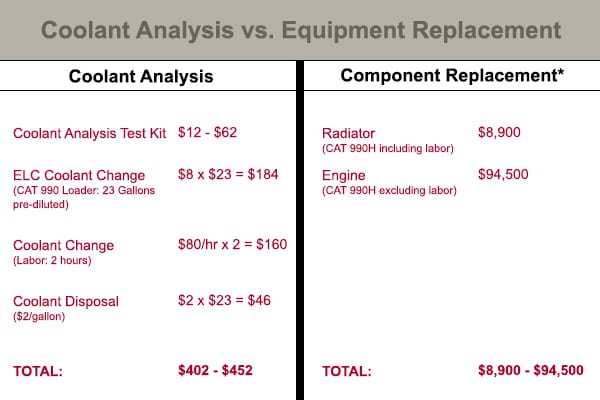Coolant analysis can have a significant impact on a heavy duty fleet manager’s operations. Routine testing increases machinery reliability and extends equipment life, enabling maintenance managers to improve productivity levels, reduce repair and replacement costs and make a positive contribution to the company’s bottom line.
The implementation of an efficient and effective coolant analysis program is continually focused on achieving four main equipment maintenance goals:
Goal #1 – Optimize Fluid Condition
The coolant formulations on the market today are designed for optimum performance for a million miles or more, which is achievable if the system and the fluid are properly maintained. Quality coolant analysis identifies cooling system issues in their earliest stages and is the best indicator of a coolant’s suitability for continued use. Routine testing and analysis at regularly scheduled PMs provides fleet managers with any corrective actions necessary before damage to the fluid has occurred.
For example, if the coolant has become darker in color, has a burnt odor and testing has detected the presence of degradation acids and a significant drop in pH, the data analyst may recommend checking for plugged EGR cooler passages which can cause “super heating.” These hot spots, or localized overheating, can cause glycol degradation that can eventually result in the formation of damaging acids that attack system metals. Coolant analysis can identify the issue before the fluid has been compromised.
When coolant replacement is necessary, the testing laboratory can provide proper fluid change recommendations.
Goal #2 – Identify Component Failure
Coolant analysis can also identify engine or cooling system component failure, such as a blown head gasket, a corroded ground, air leaks, a blocked coolant line or an EGR failure. It can also pinpoint the cause of a failure enabling the data analyst to make informed recommendations for correcting the issue and establishing the proper fluid maintenance procedures for preventing a recurrence.
For example, elevated levels of lead and other metals could be an indication of solder corrosion plugging coolant passages in the radiator and the resulting restriction of coolant flow is causing cavitation of system metals. If pH is low, the cavitation could be causing a breakdown of the glycol and it won’t be long before increased temperatures begin to form acids that will damage system metals.
Goal #3 – Predict Component Failure
A quality coolant analysis program can predict impending failures as well by pinpointing  abnormalities and trends in test results. Extremely high metal corrosion, a significant drop in nitrite and an increase in nitrate in a very short period of time could indicate electrolysis, which occurs when stray current is grounding through the coolant. While aluminum components are especially prone to electrolysis, it can even corrode a cast iron block. As little at 0.5v can destroy an engine in very little time.
abnormalities and trends in test results. Extremely high metal corrosion, a significant drop in nitrite and an increase in nitrate in a very short period of time could indicate electrolysis, which occurs when stray current is grounding through the coolant. While aluminum components are especially prone to electrolysis, it can even corrode a cast iron block. As little at 0.5v can destroy an engine in very little time.
A stray current can be caused by a loose or dirty ground strap, the addition of electronics that are not properly grounded or a system not being grounded properly. A stray current will take the path of least resistance and many times that is through the cooling system.
Goal #4 – Manage Equipment Life Cycles
Coolant analysis can even identify deficiencies in operational procedures and maintenance practices, such as improper top off, coolant mixing, inadequate maintenance of coolant inhibitors and mechanical issues affecting the coolant’s ability to protect the system.
 For example, higher calcium and magnesium results than the previous analysis with indication of no water top off and a significant drop in pH can indicate that scale-forming contaminants are entering the system from an air leak, such as a loose hose clamp or defective pressure cap. Allowing excessive scale to form on hot metal surfaces contributes to a loss of heat transfer, which can result in cracked heads, head gasket failure, stopped up radiators and oil coolers, burnt valves and lubricant degradation to a point that jeopardizes transmission life. High fluid temperatures not only reduce the life of the lubricant, they increase internal component temperatures, lower lubricity and promote engine and cooling system wear.
For example, higher calcium and magnesium results than the previous analysis with indication of no water top off and a significant drop in pH can indicate that scale-forming contaminants are entering the system from an air leak, such as a loose hose clamp or defective pressure cap. Allowing excessive scale to form on hot metal surfaces contributes to a loss of heat transfer, which can result in cracked heads, head gasket failure, stopped up radiators and oil coolers, burnt valves and lubricant degradation to a point that jeopardizes transmission life. High fluid temperatures not only reduce the life of the lubricant, they increase internal component temperatures, lower lubricity and promote engine and cooling system wear.
The True Cost of Neglecting Your Cooling System
The cost of coolant testing and analysis can drastically decrease maintenance expenses. Finding small issues within the cooling system that can lead to the damage or failure of multiple machine systems and internal components saves money. It improves machine reliability and reduces equipment repair and replacement costs.
As the following chart illustrates, a relatively small investment in coolant analysis can produce a significant return when the cost of equipment and its criticality to production are taken into consideration.

*Component replacement total does not include revenue lost while machine is out of production.
